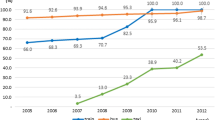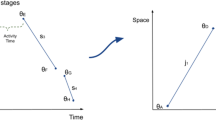Abstract
Planners must understand how public transportation systems are used in order to make strategic decisions. Smart card transaction data provides vast, detailed records of network usage. Combined with other automatically collected data sources, established inference methodologies can convert smart card transactions into complete linked journeys made by individuals within the public transport network. However, for large, multi-modal public transport networks it can be challenging to summarize the journey records meaningfully. This paper develops a method for categorizing origin–destination (OD) pairs by public transport mode or combination of used modes. By aggregating across OD pairs, this categorization scheme summarizes the multi-modal aspects of public transport network usage. The methodology can also be applied to subsets of data filtered by time of day or geography. The categorization results can inform performance analysis of OD pairs, allowing planners to make comparisons between pairs served by different combinations of modes. London Oyster card data is analyzed to illustrate how the OD pair categorization can characterize a network, allowing planners to quickly assess the roles of different modes, and perform OD pair analysis in a multi-modal public transport network.

















Similar content being viewed by others
References
Arthur D, Vassilvitskii S (2007) k-means++: the advantages of careful seeding. In: Proceedings of the eighteenth annual ACM-SIAM symposium on discrete algorithms, pp 1027–1035
Bagchi M, White P (2005) The potential of public transport smart card data. Transp Policy 12(5):464–474
Chu AKK, Chapleau R (2008) Enriching archived smart card transaction data for transit demand modeling. Transp Res Rec: J Transp Res Board 2063(1):63–72
Derrible S, Kennedy C (2010) Characterizing metro networks: state, form, and structure. Transportation 37(2):275–297
Garrison WL, Marble DF (1964) Factor-analytic study of the connectivity of a transportation network. Pap Reg Sci 12(1):231–238
Gordon JB, Koutsopoulos HN, Wilson NH, Attanucci JP (2013) Automated inference of linked transit journeys in London using fare-transaction and vehicle location data. Transp Res Rec: J Transp Res Board 2343(1):17–24
Gordon SR (1974) Relationships between economies of scale and the shape of transportation networks. Ph.D. thesis, Massachusetts Institute of Technology
Lloyd S (1982) Least squares quantization in pcm. Inf Theory IEEE Trans 28(2):129–137
MacQueen J (1967) Some methods for classification and analysis of multivariate observations. In: Proceedings of the fifth Berkeley symposium on mathematical statistics and probability, Oakland, CA, USA, vol 1, pp 281–297
Maimon O, Rokach L (2005) Data mining and knowledge discovery handbook, vol 2. Springer, New York
Morency C, Trepanier M, Agard B (2007) Measuring transit use variability with smart-card data. Transp Policy 14(3):193–203
Pelletier MP, Trépanier M, Morency C (2011) Smart card data use in public transit: a literature review. Transp Res Part C: Emerg Technol 19(4):557–568
Rousseeuw PJ (1987) Silhouettes: a graphical aid to the interpretation and validation of cluster analysis. J Comput Appl Math 20:53–65
Transport for London (2012) Join in the celebration across the capital this summer with a limited edition summer Oyster card (press release). Retrieved from: https://tfl.gov.uk/info-for/media/press-releases/2012/june/join-in-the-celebrations-across-the-capital-this-summer-with-a-limited-edition-summer-oyster-card
Utsunomiya M, Attanucci J, Wilson N (2006) Potential uses of transit smart card registration and transaction data to improve transit planning. Transp Res Rec: J Transp Res Board 1971(1):119–126
Viggiano C, Koutsopoulos HN, Attanucci J, Wilson NH (2016) Inferring public transport access distance from smart card registration and transaction data. Transp Res Rec: J Transp Res Board 2544 (forthcoming)
Vuchic VR, Musso A (1991) Theory and practice of metro network design. Public Transp Int 40(3/91):298–325
Acknowledgements
Many thanks to Transport for London for the support, guidance, and oversight of this research.
Author information
Authors and Affiliations
Corresponding author
Rights and permissions
About this article
Cite this article
Viggiano, C., Koutsopoulos, H.N., Wilson, N.H.M. et al. Journey-based characterization of multi-modal public transportation networks. Public Transp 9, 437–461 (2017). https://doi.org/10.1007/s12469-016-0145-8
Accepted:
Published:
Issue Date:
DOI: https://doi.org/10.1007/s12469-016-0145-8




